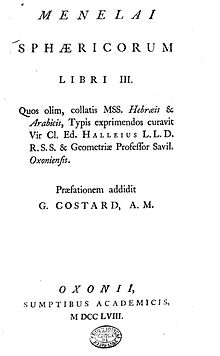astro.wikisort.org - Researcher
Menelaus of Alexandria (/ˌmɛnɪˈleɪəs/; Greek: Μενέλαος ὁ Ἀλεξανδρεύς, Menelaos ho Alexandreus; c. 70 – 140 CE) was a Greek[1] mathematician and astronomer, the first to recognize geodesics on a curved surface as natural analogs of straight lines.

Life and works

Although very little is known about Menelaus's life, it is supposed that he lived in Rome, where he probably moved after having spent his youth in Alexandria. He was called Menelaus of Alexandria by both Pappus of Alexandria and Proclus, and a conversation of his with Lucius, held in Rome, is recorded by Plutarch.
Ptolemy (2nd century CE) also mentions, in his work Almagest (VII.3), two astronomical observations made by Menelaus in Rome in January of the year 98. These were occultations of the stars Spica and Beta Scorpii by the moon, a few nights apart. Ptolemy used these observations to confirm precession of the equinoxes, a phenomenon that had been discovered by Hipparchus in the 2nd century BCE.
Sphaerica is the only book that has survived, in an Arabic translation. Composed of three books, it deals with the geometry of the sphere and its application in astronomical measurements and calculations. The book introduces the concept of spherical triangle (figures formed of three great circle arcs, which he named "trilaterals") and proves Menelaus' theorem on collinearity of points on the edges of a triangle (which may have been previously known) and its analog for spherical triangles. It was later translated by the sixteenth century astronomer and mathematician Francesco Maurolico.
The lunar crater Menelaus is named after him.
Bibliography
The titles of a few books by Menelaus have been preserved:
- On the calculation of the chords in a circle, composed of six books
- Elements of geometry, composed of three books, later edited by Thabit ibn Qurra
- On the knowledge of the weights and distributions of different bodies
- He may also have written a star catalogue.
Notes
- Encyclopædia Britannica "Greek mathematician and astronomer who first conceived and defined a spherical triangle (a triangle formed by three arcs of great circles on the surface of a sphere)."
References
- Ivor Bulmer-Thomas. "Menelaus of Alexandria." Dictionary of Scientific Biography 9:296-302.
- Pedro Pablo Fuentes González, “Ménélaos d’Alexandrie”, in R. Goulet (ed.), Dictionnaire des Philosophes Antiques, vol. IV, Paris, CNRS, 2005, p. 456-464.
- Roshdi Rashed and Athanase Papadopoulos, Menelaus' Spherics. Early Translation and al-Māhānī / al-Harawī's Version. De Gruyter, Scientia Graeco-Arabica 21. xiv, 874 pages. ISBN 978-3-11-056987-2
External links
- O'Connor, John J.; Robertson, Edmund F., "Menelaus of Alexandria", MacTutor History of Mathematics archive, University of St Andrews
- Halley's Latin Translation from the Arabic and Hebrew Versions (three books) at Google Books
На других языках
- [en] Menelaus of Alexandria
[es] Menelao de Alejandría
Menelao de Alejandría (c. 70 d.C. – 140 d. C.) fue un matemático y astrónomo griego, que trabajó en Alejandría y en Roma a finales del siglo I. Fue el primero en reconocer las líneas geodésicas en una superficie curva como análogas naturales de las líneas rectas y en concebir y definir el triángulo esférico.[1] Su nombre ha quedado ligado al teorema de geometría plana o esférica relativo a un triángulo cortado por una recta o un círculo máximo, conocido como el teorema de Menelao, un teorema de una gran importancia en la trigonometría antigua. También fue un defensor entusiasta de la geometría clásica.[it] Menelao di Alessandria
Menelao di Alessandria (Alessandria d'Egitto, 70 circa – Roma, 140 circa) è stato un matematico e astronomo greco antico di cui si conserva un importante trattato di geometria sferica, lo Sphaerica.[ru] Менелай Александрийский
Менела́й Александри́йский (Μενέλαος ὁ Αλεξανδρεύς, ок. 100 н. э.) — древнегреческий математик и астроном. Время его жизни и деятельности примерно определяется приведёнными в «Альмагесте» Птолемея двумя астрономическими наблюдениями, которые Менелай произвёл в Риме в первом году царствования Траяна, то есть в 98 году н. э..Другой контент может иметь иную лицензию. Перед использованием материалов сайта WikiSort.org внимательно изучите правила лицензирования конкретных элементов наполнения сайта.
WikiSort.org - проект по пересортировке и дополнению контента Википедии